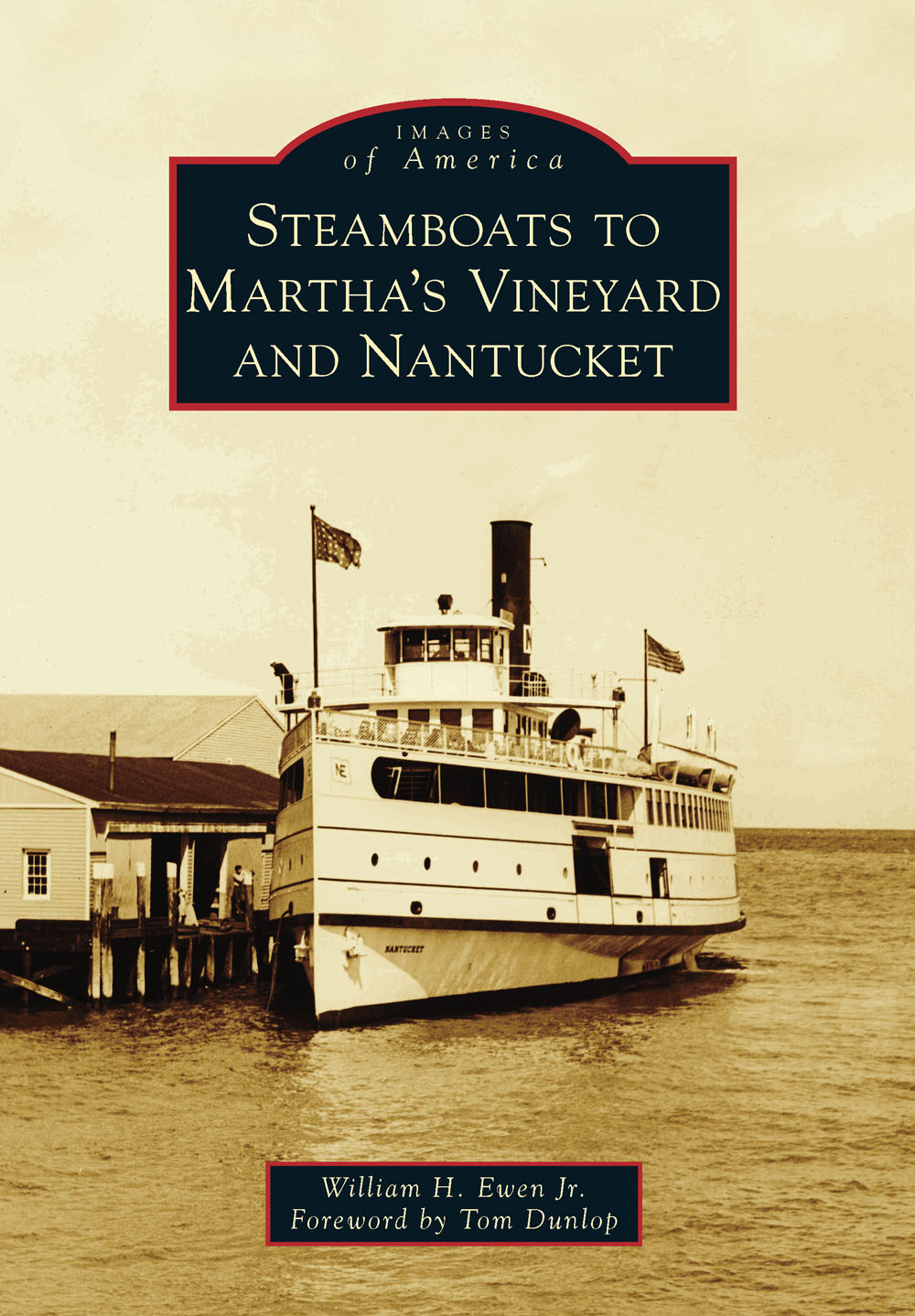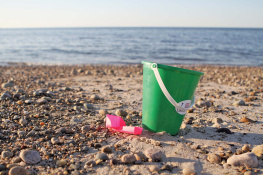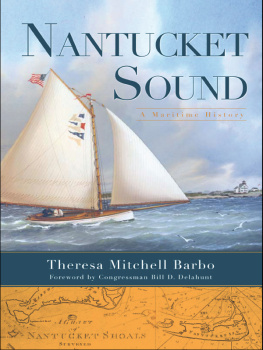
IMAGES
of America
STEAMBOATS TO
MARTHAS VINEYARD
AND NANTUCKET

This map is from a 1913 New England Steamship Company brochure and includes the area of steamboat operations covered in this book. The islands of Marthas Vineyard and Nantucket are at lower right, along with the route of the island steamers at the time. The heavy dotted lines going off to the left indicate the night lines to New York. (Authors collection.)
ON THE COVER: In a scene from the 1930s, the steamer Nantucket is moored to the south side of the wharf at Oak Bluffs on Marthas Vineyard. The Nantucket was built in 1925 as the Nobska and was renamed in 1928. In 1957, she received her original name back, and as Nobska, she ran until the end of the 1973 season. (Photograph by William K. Covell; authors collection.)
IMAGES
of America
STEAMBOATS TO
MARTHAS VINEYARD
AND NANTUCKET
William H. Ewen Jr.
Foreword by Tom Dunlop

Copyright 2015 by William H. Ewen Jr.
ISBN 978-1-4671-2282-5
Ebook ISBN 9781439650530
Published by Arcadia Publishing
Charleston, South Carolina
Library of Congress Control Number: 2014944514
For all general information, please contact Arcadia Publishing:
Telephone 843-853-2070
Fax 843-853-0044
E-mail
For customer service and orders:
Toll-Free 1-888-313-2665
Visit us on the Internet at www.arcadiapublishing.com
This book is dedicated to my late parents, Cathleen and William Ewen, and to my sister, Barbara, in honor of all the boat rides we four took together.
CONTENTS
FOREWORD
I was fortunate to be standing on the wharf when the steamer Naushon rounded Nobska Point and drove her muscular way into the onrushing tides of Woods Hole, Massachusetts, on May 27, 1988. It was the final scheduled trip the Naushon ever made. I saw herwith a Dont Give Up the Ship pennant crackling from her mast topturn and back into a slip at the Woods Hole, Marthas Vineyard, and Nantucket Steamship Authority terminal. The appeal didnt work; this encore voyage of the Naushon would mark not just the last time a true steamship carried passengers and cars across the waters of Vineyard and Nantucket Sounds, but actually from anywhere to anywhere along the whole Eastern Seaboard of the United States.
The departure of the Naushon for a moribund (and finally derelict) life as a riverside casino boat in the Deep South ended 170 years of steamship history on the waters that surround Cape Cod, Marthas Vineyard, and Nantucket. No more the quiet tick of a reciprocating engine from the steam plant down below, the snug and inviting staterooms that ran along a promenade deck, or the sense that a real ship was carrying real travelers on a real voyage from the broad conventionalities of mainland life to seaward islands where everything looked encouragingly distinctive and felt gratifyingly specific.
Twenty-eight years have passed since that day when the steamer Naushon yielded her place to the efficient, but essentially indistinguishable, fleet of diesel ferries that serve the Vineyard and Nantucket today. Forty years have passed since a book told the story of the island steamships. But with Steamboats to Marthas Vineyard and Nantucket, William H. Ewen Jr. answers the call anew. Longtime summer resident of Oak Bluffs on the Vineyard, artist, steamship historian, writer, and lecturer, Ewen delivers the book of prose and photographs, many never before seen, that returns us to the decks of the island steamers at a time when everything about themfrom engine room to mast topslooked and felt as warmly and memorably individual as the islands they then served.
Tom Dunlop, author of The Chappy Ferry Book
ACKNOWLEDGMENTS
This book was a labor of love, but without the help of many, the labor would have been much more difficult. If I have forgotten anyone, I sincerely apologize. It was not intentional.
First, I want to acknowledge several who have recorded the history of the island steamers and whose works were invaluable parts of my research. They are The Story of the Island Steamers by Harry B. Turner, published in 1910; A Study of the Nantucket-Vineyard Ferry Lines, 18001948, a 1966 masters thesis at the University of Rhode Island by Edward Law Thomas; and The Island Steamers by Paul C. Morris and Joseph F. Morin, published in 1977.
I have had help with researching and locating images from several museums and libraries. I wish to thank Allynne Lange, curator of the Hudson River Maritime Museum; Mark Procknik, librarian at the New Bedford Whaling Museum Research Library; Bow Van Riper, assistant librarian at the Marthas Vineyard Museum; and Hilary Wall, archivist and librarian at the Vineyard Gazette and Marthas Vineyard Magazine.
A number of people helped in a variety of important ways, including making images available from their own or family collections, helping to locate sources, providing answers to questions, and willingly assisting in many other ways. For these things, I thank the late Bob Allen and his wife Hazel, John Boardman, Rosemary Bottum, Mike Dawicki, Barry Eager, George Fisher, Rob Gatchell, Paul Huntington, Joe Morin, Bill Muller, Ted Scull, Alison Shaw, Mark Snider, and Carl Walker.
My thanks go also to Tom Dunlop, who wrote the foreword for this book and who helped in numerous other ways.
Special thanks go to my wife, Susan, for reading the manuscript and making many helpful suggestions. I thank her for her patience as well.
Last but not least, a thank-you is owed to my editor Caitrin Cunningham, who was a great help and a pleasure to work with.
Except where otherwise noted, all images are from the authors collection.
INTRODUCTION
The Massachusetts islands of Marthas Vineyard and Nantucket are situated off the southern coast of Cape Cod. Nantucket, the smaller of the two, is approximately 30 miles offshore and Marthas Vineyard about seven miles. The first recorded sightings of both islands were by the English explorer Bartholomew Gosnold in 1602. At the time, members of the Wampanoag Indian tribe inhabited the islands.
The first real English settlement on the Vineyard, as Marthas Vineyard is commonly called, was established in 1642 and the first on Nantucket in 1659. While Marthas Vineyard remained mostly agricultural, Nantucket steadily grew as a center for whaling and refining whale oil. In the 18th and 19th centuries, Nantucket whaling ships were traveling to points around the globe on voyages that lasted three to four years. This industry, for a time, made Nantucket one of the wealthiest communities in the country. It was said that whale oil from Nantucket lit the streets of Europe.
Transportation by water was of course critical for the islands. At first, it consisted mostly of private sailing vessels for hire. As the need for reliable and regular transportation grew, especially on Nantucket, so did the push for ferry service. As early as 1694, an act for licensing and regulating ferry service was enacted. In 1695, the two islands were put in different counties so that they and their ferry services were independent of each other.
The first tentative service by steamboat came to Nantucket as early as 1818. It was not until 1846 that Marthas Vineyard got its own direct steam-powered ferry service. Engine-powered vessels did not replace the sailing packets immediately. The steamers were more expensive to build, and at least initially, the sailing vessels were often faster. But this was the beginning. Steamboats served the two islands for about 170 years before the last one departed these waters.
Next page












